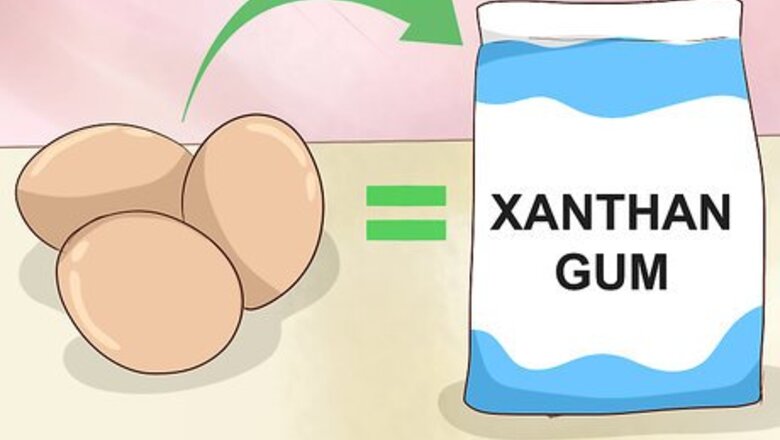
views
X
Research source
- Make your baked goods vegan or allergy-friendly by substituting 1/4 tsp xanthan gum for each egg that's called for.
- Use xanthan gum as a thickener the next time you're making a sauce, salad dressing, gravy, or smoothie.
- If you notice your xanthan gum clumping when you add it to a recipe, try dissolving it in an equal amount of oil or glycerine first.
- Make your own homemade shampoo by mixing tea, baking soda, castile soap, essential oil, and xanthan gum.
Incorporating Xanthan Gum in Recipes
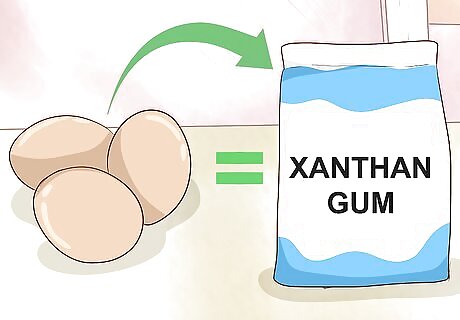
Use xanthan gum as a binder if you’re vegan or have an egg allergy. Xanthan gum is a versatile thickener, and is a great substitute for eggs in baking recipes. Simply omit the eggs and whisk 1 to 2 tsp (2 1/2 to 5 g) of xanthan gum into your dry ingredients. The more xanthan gum you use, the denser your baked good will be. In general, use 1/2 to 1 tsp (1 to 2 1/2 g) of xanthan gum per 1 c (120 g) of flour, or about 1/4 tsp (1/2 g) per egg. You can also find lots of recipes that incorporate xanthan gum online. Look for xanthan gum in your local market’s baking supplies section, or purchase it online.

Thicken sauces and condiments with 1/8 tsp (1/4 g) of xanthan gum. If you check the ingredients of your favorite salad dressing, chances are it’ll list xanthan gum. Try adding a pinch to your next made-from-scratch pan sauce, gravy, or dressing. It acts as an emulsifier, which means it helps thicken sauces and condiments and keeps them from separating. For instance, blend together 2 ⁄2 c (590 mL) of ketchup and 2 US tbsp (30 mL) each of soy sauce, yuzu-kosho paste, and yuzu juice. When the ingredients are well-combined, add 1/8 (1/2 g) of xanthan gum, then blend on low for 10 to 20 seconds.

Make lower-calorie smoothies and cocktails with it. Instead of using yogurt or ice cream, thicken your healthy smoothies with 1/2 to 1 tsp (1 to 2 1/2 g) of xanthan gum per 1 cup (240 mL) of liquid ingredients. Remember, more xanthan gum means a thicker mixture, so use more or less of it based on your preferences. If you’re a fan of frothy cocktails, like a gin fizz, but want to nix the egg white and its extra calories, try adding a pinch of xanthan gum to your cocktail shaker. For sweetened drinks, such as margaritas, try making a simple syrup by boiling equal parts water and sugar until the sugar is dissolved. Let the syrup cool to room temperature, transfer it to a blender, add 1/8 tsp (1/2 g) of xanthan gum, and blend the syrup on low for about 15 seconds.
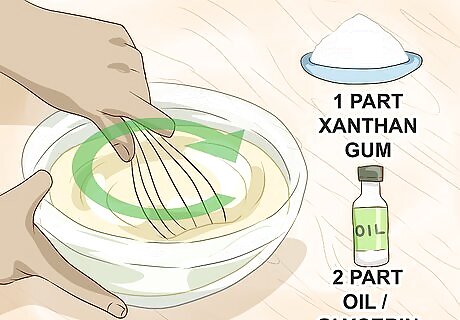
Whisk it with oil or glycerin to prevent clumping. Xanthan gum is water soluble and dissolves in both warm and cold water. However, it sometimes forms clumps, especially when it’s not mixed vigorously. To help it dissolve evenly, try whisking 1 part of xanthan gum with 1 to 2 parts of oil or glycerin before adding it to liquids. You can find glycerin at grocery stores, pharmacies, and online. You may also see it labeled as glycerol or glycerine. When you add xanthan gum in powdered or dissolved forms to a liquid, be sure to stir constantly until the liquid thickens. When you add xanthan gum in powdered form to dry ingredients, such as flour, whisk it in thoroughly to disperse it evenly.
Baking Vegan Chocolate Cake
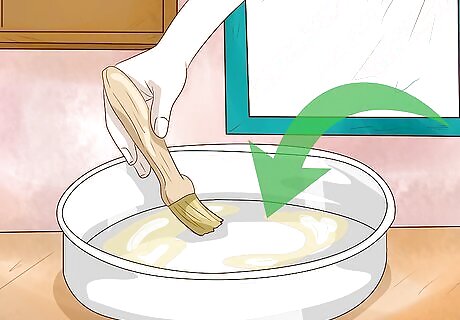
Coat a 9 by 13 in (23 by 33 cm) cake pan with oil or cooking spray. Dampen a paper towel with about 1 US tbsp (15 mL) of canola or vegetable oil, then wipe it across the bottom of your cake pan. Alternatively, grease the bottom of the pan with cooking spray. You can also use a bundt pan or muffin tin. If you do, you’ll just need to tweak your baking time.

Whisk together the flour, cocoa, xanthan gum, baking soda, and salt. Pour the dry ingredients into a medium mixing bowl, then whisk them together until they’re evenly combined. Be sure to use a whisk instead of a spoon or rubber spatula. Whisking will help break down any lumps.
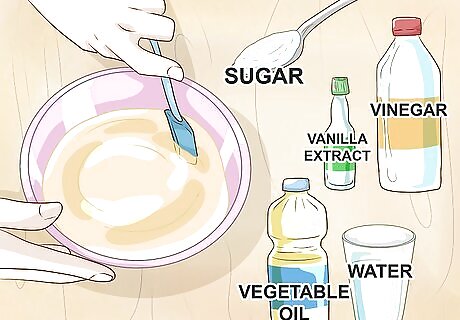
Combine the vegetable oil, sugar, water, vinegar, and vanilla extract. Using a rubber spatula, mix the oil and sugar together in a large mixing bowl (not the same bowl as the dry ingredients). Then add the water, vinegar, and vanilla, and stir the wet ingredients until they’re well combined. You might think that sugar counts as a dry ingredient but, in baking, it falls into the wet group.
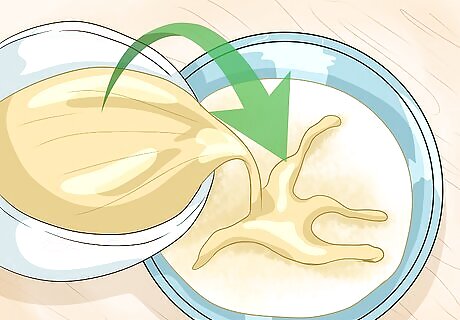
Mix together the wet and dry ingredients. Pour about half of the dry ingredients to the wet, and mix them together with the rubber spatula. When they’re combined, add the rest of the dry ingredients. Stir just until the batter is moistened, then pour it into the cake pan. Over-mixing the batter can lead to a tough, dense cake, so stop stirring when you can no longer see any streaks of the dry ingredients.

Bake in an oven preheated to 350 °F (177 °C) for 40 minutes. Bake the cake until a toothpick inserted into the center comes out with no traces of wet batter. Remove it from the oven, and let it cool in the pan for 10 minutes on a wire rack. If you used a bundt pan, the baking time will be about 55 minutes. For a muffin tin, bake the batter for 22 minutes.
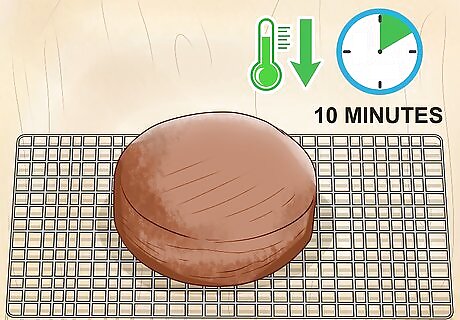
Transfer the cake to a wire rack. After letting it cool for 10 minutes, run a knife or thin metal spatula around the cake’s rim. Hold the wire rack over the top of the pan, flip it over to invert the cake onto the rack, then lift off the cake pan. If you used a muffin tin, place a towel over the pan, flip it upside down, and catch the cupcakes with the towel. Then place them on a wire rack to cool completely. The pan or tin will still be hot, so handle it with an oven mitt.
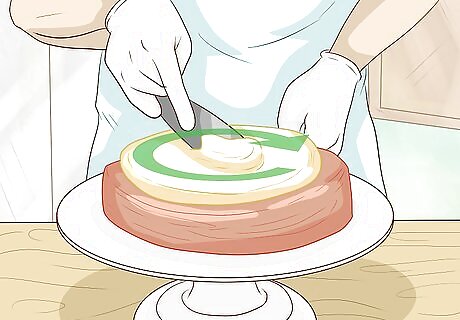
Frost the cake once it’s cooled to room temperature. Allow the cake to cool for 1 to 2 hours, then transfer it to a cake plate. Use a butter knife or off-set spatula to apply your favorite vegan frosting, then slice and serve it for dessert. A cooled cake is easier to frost, and you’ll make fewer crumbs. If you made a bundt cake, use a sugar dispenser or fine-mesh strainer to sprinkle it with confectioners’ sugar.

Store leftovers for 3 to 4 days. Keep the cake in a covered container at room temperature. Since cut edges are prone to going stale, stick sheets of plastic wrap over them to help keep the cake fresh.
Whipping up a Piña Colada Protein Smoothie

Add the ingredients to a blender, starting with the liquids. Pour the milk in first, then add the coconut extract, the pineapples, the protein powder, xanthan gum, and frozen banana, in that order. Adding liquid ingredients first is easier on your blender and speeds up the blending process.

Blend the ingredients until they’re smooth. Start on low speed until the frozen banana starts to break up and a vortex forms in the center of the blender. Then gradually increase speed until the ingredients are smoothly blended, or about 2 to 3 minutes. If you set your blender to high right away, the blades will just splatter the ingredients up and away instead of chopping them.
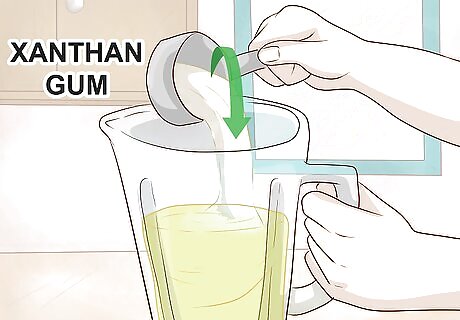
Add more or less xanthan gum to adjust the texture. If you want a thinner smoothie, add half as much xanthan gum to the blender. For a sweet alternative to ice cream or frozen yogurt, add about 1/2 tsp (1 g) more to thicken your smoothie into a thick dessert cup. Try topping your dessert cup with shaved coconut, slivered almonds, or sliced strawberries.
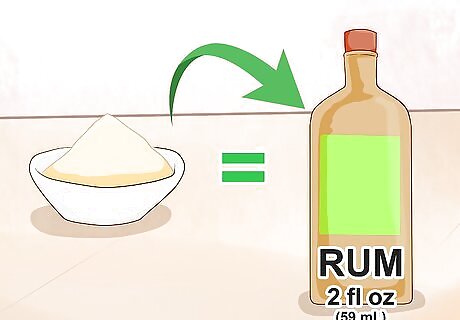
Swap the protein powder for 2 fl oz (59 mL) of rum for a classic cocktail. A protein shake is a healthy, quick breakfast option, but maybe you’re in the mood for a refreshing cocktail. Skip the protein powder, and add your choice of dark or light rum for a frothy, luxurious piña colada.
Making Homemade Tea Shampoo

Brew 1 US gal (3.8 L) of tea for 5 to 6 minutes. Pour the water into a large pot, then bring it just to a boil over medium-high heat. Once it reaches a boil, turn off the heat, add tea leaves or tea bags, and steep them for 5 to 6 minutes. As a rule of thumb, use 1 tea bag or about 1 tbsp (2 g) of loose tea per 1 c (240 mL) of water. For 1 US gal (3.8 L) of tea, use 16 tea bags or about 1 c (32 g) of loose tea. Go with your favorite tea, or a variety with a scent you love. Green, lavender or citrus teas make great fragrances for shampoos. Note that strong black, raspberry, rosemary, or sage teas may darken your hair, and chamomile, turmeric, and calendula teas can lighten or add highlights. The effects usually aren’t dramatic after just one use. If you do want to use a tea shampoo to dye your hair, apply it every 1 to 2 days until you’ve achieved your desired shade.
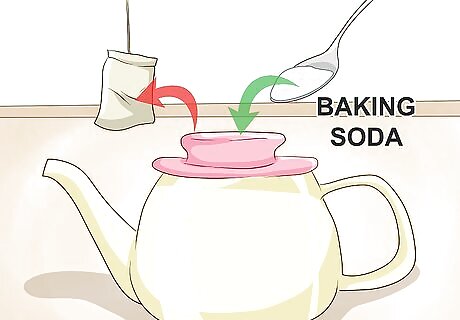
Remove the tea bags, then add the baking soda. After steeping the tea for 5 to 6 minutes, scoop out the bags with a slotted spoon, or strain out the loose leaves. Then stir in the baking soda until it’s completely dissolved. The baking soda will fizz a bit, so be sure to use a large pot. It won’t be a volcano, but it could bubble over if the water fills the pot right to the brim.
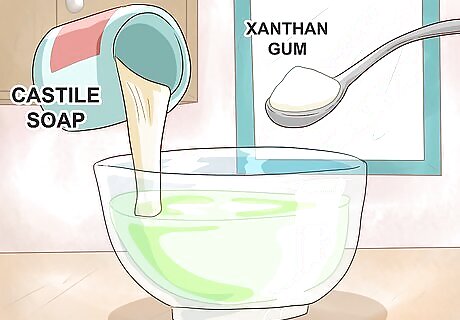
Cool the mixture, then stir in the xanthan gum and castile soap. Let the mixture cool to room temperature for at least 30 to 60 minutes. Add the xanthan gum first, stir vigorously to distribute it, then mix in the castile soap. Stir constantly as you add the xanthan gum and castile soap until the mixture starts to thicken and froth. Stirring constantly can help reduce the risk of clumping. If you’re worried about clumping, try whisking the xanthan gum with 2 to 3 teaspoons (9.9 to 14.8 mL) of glycerin before adding it to the tea mixture.

Mix in 10 drops of your favorite essential oils to add fragrance. If you’re not sure which essential oils to use, try experimenting with various combinations. For instance, mint and rosemary oils are a good combination, and peppermint essential oil may also promote hair growth. If you love citrus flavors and fragrances, go with lemon or wild orange teas and oils. Try combining 4 or 5 drops of tea tree oil with 5 or 6 drops of lemon, orange, or lavender essential oils. Tea tree oil may help treat dandruff and promote scalp health. Before using an essential oil, do a patch test. Mix 1 drop of essential oil in ⁄4 c (59 mL) of coconut or olive oil. Apply 2 to 3 drops of the mixture to a bandage, wear it on the inside of your forearm, and check it after 48 hours. Don't use the essential oil if you notice any signs of irritation.

Pour your shampoo into a bottle. Purchase a container with a spout, or rinse out and reuse an old store-bought shampoo bottle. Use a 1 US gal (3.8 L) bottle, or divide your shampoo into multiple smaller bottles. Remove the bottle's cover, place a funnel into the opening, and fill it with your shampoo. If possible, use 1 hand to hold the funnel and bottle in place, and the other to pour. If you need 2 hands to hold the pot of shampoo, have a helper hold the bottle steady. Store the shampoo in the fridge for 2 to 3 months. For convenience, store the main batch in the fridge, and keep a 2 to 3 day supply in the shower. For a smaller batch, just use half (or a third or a quarter) of each ingredient; just make sure your proportions are the same.


















Comments
0 comment